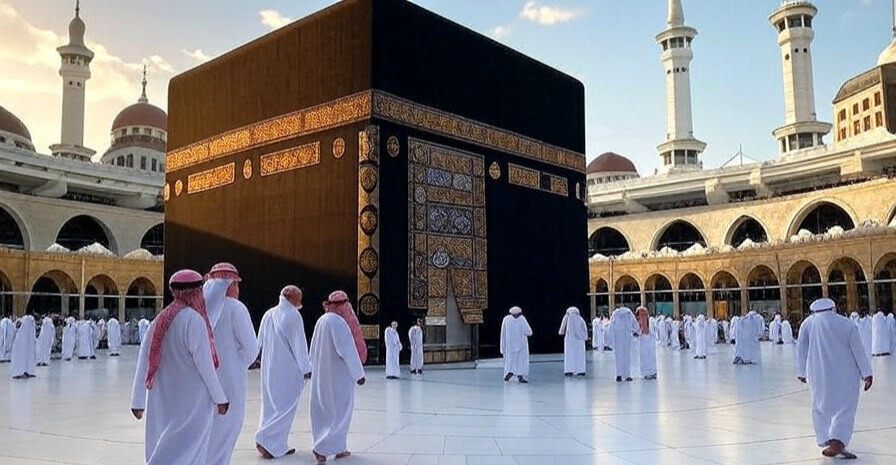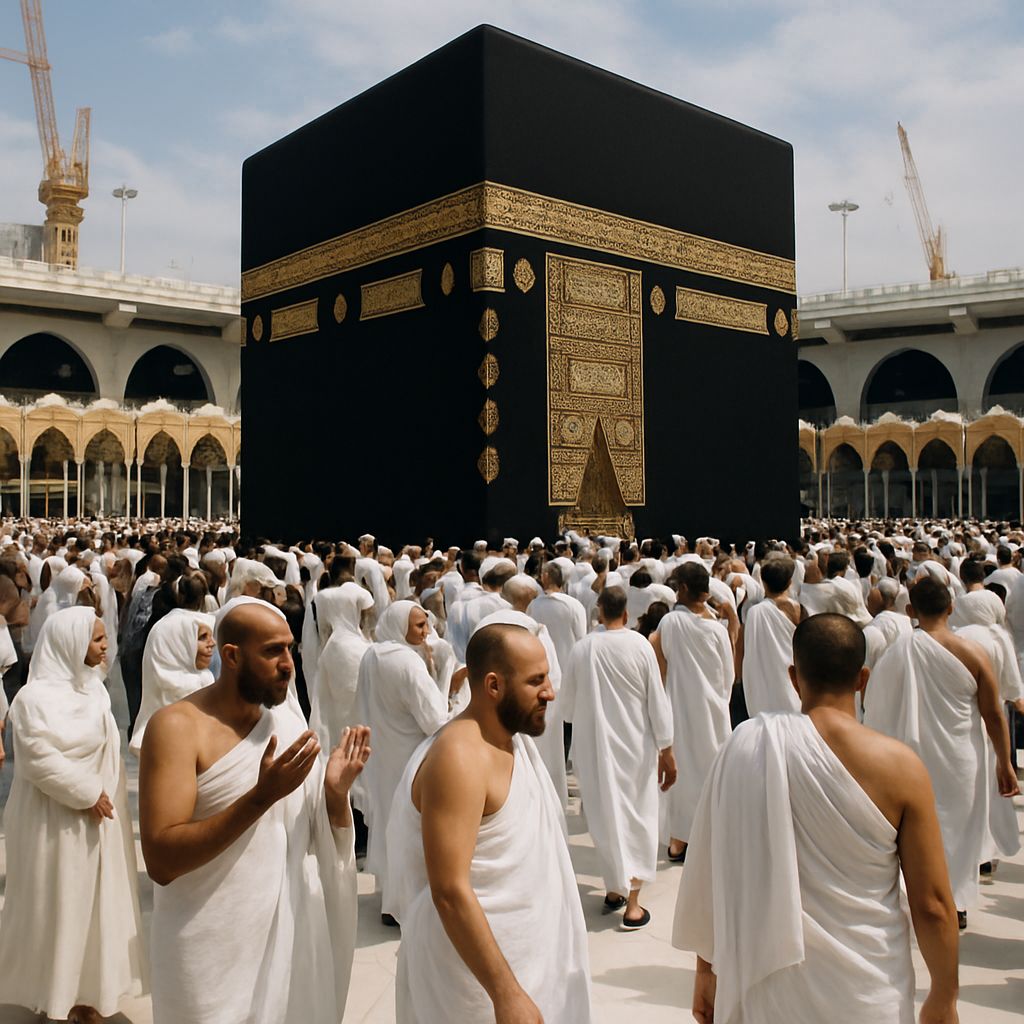Complete Guide to Hajj 2025 and Eid al-Adha: Sacred Islamic Pilgrimage Explained
Hajj 2025 is approaching fast! June 4-9, 2025 marks one of Islam’s most sacred journeys. Every year, millions of Muslims from around the world gather in Mecca, Saudi Arabia, to perform this life-changing pilgrimage. Whether you’re planning your first Hajj journey or seeking to understand this profound Islamic tradition, this comprehensive guide covers everything you need to know about Hajj rituals, Eid al-Adha celebrations, and their spiritual significance.
What is Hajj? Understanding the Sacred Islamic Pilgrimage
Hajj represents the fifth and final pillar of Islam, making it a fundamental religious duty for every Muslim. This ancient pilgrimage to Mecca holds deep spiritual meaning, tracing back to Prophet Ibrahim (Abraham) and his family thousands of years ago.
Why is Hajj Important for Muslims Worldwide?
The significance of Hajj extends far beyond a simple journey. It serves multiple spiritual and social purposes:
- Spiritual Purification: Muslims believe that completing Hajj with sincere intention cleanses all previous sins
- Global Unity: People from every race, nationality, and social class worship together as equals
- Following Prophet’s Example: Pilgrims follow the same steps performed by Prophet Muhammad (PBUH)
- Personal Transformation: The challenging journey promotes self-reflection and spiritual growth
- Community Building: Hajj strengthens bonds among the global Muslim community
Did You Know? Approximately 1.8 million Muslims are preparing for Hajj 2025, making it one of the world’s largest annual gatherings.
Hajj 2025 Dates and Timeline: When Does the Pilgrimage Begin?
Based on the Islamic lunar calendar, Hajj 2025 is expected to begin on June 4th and conclude on June 9th, 2025. The pilgrimage occurs during Dhu al-Hijjah, the twelfth month of the Islamic calendar.
| Day | Islamic Date | Gregorian Date 2025 | Main Activities |
|---|---|---|---|
| Day of Tarwiyah | 8th Dhu al-Hijjah | June 4, 2025 | Journey to Mina, Enter Ihram State |
| Day of Arafah | 9th Dhu al-Hijjah | June 5, 2025 | Standing at Mount Arafat (Most Important Day) |
| Eid al-Adha | 10th Dhu al-Hijjah | June 6, 2025 | Stoning, Sacrifice, Celebration Begins |
| Days of Tashreeq | 11th-12th Dhu al-Hijjah | June 7-8, 2025 | Continued Stoning Rituals |
| Farewell Tawaf | 13th Dhu al-Hijjah | June 9, 2025 | Final Circumambulation of Kaaba |
Step-by-Step Hajj Rituals: What Muslims Do During Pilgrimage
The Hajj journey involves several sacred rituals performed in a specific sequence. Each act carries deep spiritual meaning and connects pilgrims to Islamic history.
Pre-Hajj Preparation: Entering the Sacred State
Before beginning the pilgrimage, Muslims must enter a state called Ihram. This involves:
- Wearing special white garments (two seamless white cloths for men, modest clothing for women)
- Making the intention (Niyyah) to perform Hajj
- Reciting the Talbiyah prayer repeatedly
- Following specific behavioral guidelines (no arguing, fighting, or intimate relations)
The Five Essential Hajj Rituals Muslims Must Perform
1. Tawaf – Circumambulation of the Holy Kaaba
Pilgrims circle the cube-shaped Kaaba seven times counterclockwise, expressing their devotion to Allah. This represents the unity of believers worshipping the One God.
2. Sa’i – Walking Between Safa and Marwah Hills
This ritual commemorates Hagar’s search for water for her son Ishmael. Pilgrims walk seven times between the two hills, now enclosed within the Grand Mosque.
3. Standing at Mount Arafat (Wuquf)
The most crucial day of Hajj occurs on the 9th of Dhu al-Hijjah. Pilgrims gather at Mount Arafat from noon until sunset, praying and seeking forgiveness. This represents the Day of Judgment.
4. Stoning of the Devil (Rami al-Jamarat)
Pilgrims throw pebbles at three stone pillars representing Satan’s temptation of Ibrahim. This symbolizes rejection of evil and temptation.
5. Animal Sacrifice (Qurbani)
Following Ibrahim’s example, pilgrims sacrifice an animal (sheep, goat, cow, or camel) and distribute the meat to family and the needy.
Understanding Eid al-Adha: The Festival of Sacrifice
Eid al-Adha, also known as the “Festival of Sacrifice,” represents one of Islam’s most significant celebrations. Eid al-Adha 2025 will begin on the evening of Friday, June 6 and marks the climax of the Hajj pilgrimage.
Why Do Muslims Celebrate Eid al-Adha?
This festival commemorates Prophet Ibrahim’s (Abraham’s) willingness to sacrifice his son Ishmael as commanded by Allah. When Ibrahim demonstrated his complete obedience, Allah provided a ram as a substitute sacrifice, teaching the importance of faith and submission.
🕌 Eid Prayer
Muslims gather for special congregational prayers at mosques, often followed by sermons about sacrifice and faith.
🐑 Qurbani (Sacrifice)
Families who can afford it sacrifice livestock, distributing meat among family, friends, and the needy in three equal parts.
🤝 Community Gathering
Families come together for festive meals, exchange gifts, and strengthen community bonds through shared celebration.
💰 Charity and Giving
Emphasis on helping the less fortunate through increased charitable giving and sharing resources with those in need.
The Five Pillars of Islam: Where Hajj Fits In
To understand Hajj’s importance, it’s essential to know its place among Islam’s Five Pillars. These fundamental practices form the foundation of Muslim faith and practice:
- Shahada (Declaration of Faith): Testifying that there is no god but Allah and Muhammad is His messenger
- Salah (Prayer): Performing five daily prayers facing Mecca
- Zakat (Charitable Giving): Giving a portion of wealth to help the poor and needy
- Sawm (Fasting): Fasting during the holy month of Ramadan
- Hajj (Pilgrimage): Making the journey to Mecca at least once in a lifetime if physically and financially able
Modern Hajj Experience: Technology and Innovations in 2025
Saudi Arabia continues modernizing the Hajj experience while preserving its spiritual essence. Recent technological innovations are transforming the pilgrimage, making it safer and more accessible for millions of participants.
Health and Safety Measures for Hajj 2025
The Saudi government implements comprehensive health protocols to ensure pilgrim safety. For the latest health guidelines and travel requirements, visit our health section for updated information.
Planning Your Hajj Journey: Essential Information
Who Can Perform Hajj?
- Adult Muslims (male and female)
- Physically capable of undertaking the journey
- Financially able to afford the pilgrimage
- Women must be accompanied by a male guardian (Mahram)
- Must obtain proper Hajj visa and permits
Hajj Visa and Requirements
Saudi Arabia strictly regulates Hajj participation through authorized tour operators. Pilgrims must:
- Apply through licensed Hajj tour companies
- Provide required medical certificates and vaccinations
- Pay applicable fees and deposits
- Follow designated departure dates
Important Note: Under current regulations, children will not be permitted to accompany pilgrims during Hajj 2025, as announced by Saudi Arabia’s Ministry of Hajj and Umrah for safety reasons.
Spiritual Benefits of Hajj and Eid al-Adha
Beyond the physical journey, Hajj and Eid al-Adha offer profound spiritual benefits:
Personal Transformation Through Pilgrimage
- Spiritual Cleansing: Muslims believe sincere Hajj performance forgives all previous sins
- Increased Faith: Direct connection with Islamic history strengthens religious conviction
- Humility and Equality: Identical dress and rituals eliminate social distinctions
- Global Brotherhood: Meeting Muslims from diverse cultures promotes universal unity
- Self-Discipline: Following strict guidelines develops personal control and patience
Celebrating Eid al-Adha Worldwide
While Hajj pilgrims celebrate in Mecca, Muslims worldwide participate in Eid al-Adha festivities. The celebration typically lasts three to four days and includes:
Traditional Eid al-Adha Activities
- Morning Prayers: Special Eid prayers at mosques followed by community gatherings
- Family Reunions: Extended families come together for shared meals and celebration
- Gift Exchange: Children often receive new clothes, toys, and money
- Charitable Acts: Increased focus on helping the less fortunate through donations
- Cultural Foods: Traditional dishes and sweets prepared for the occasion
For more cultural celebrations and traditions, explore our entertainment section for diverse festival coverage worldwide.
Conclusion: The Lasting Impact of Hajj and Eid al-Adha
Hajj 2025 and Eid al-Adha represent more than religious obligations; they embody Islam’s core values of faith, sacrifice, unity, and compassion. Whether participating in the pilgrimage or celebrating from afar, these sacred observances remind Muslims of their spiritual duties and connection to the global Islamic community.
The journey to Mecca transforms lives, while Eid al-Adha celebrations strengthen family bonds and community support. Together, they demonstrate Islam’s emphasis on both personal spiritual growth and collective social responsibility.
Stay informed about Hajj 2025 developments and other breaking news by visiting Kashmir News homepage. For latest updates on pilgrimage preparations and global Islamic events, check our breaking news section.
For More Information: Visit authoritative sources like Britannica’s guide to Eid al-Adha and Islamic Relief’s Eid resources for additional insights into these sacred Islamic observances.



